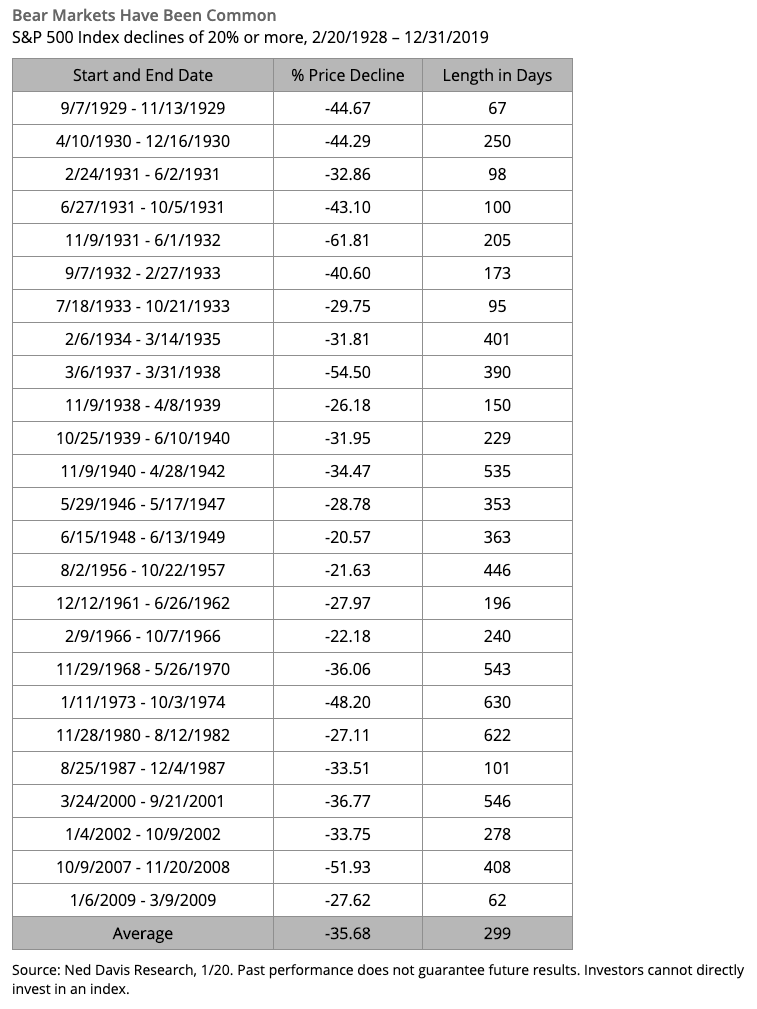Written by: Hartford Funds | Hartrford Funds
What you need to know about bear, or down, markets.
Olympic athletes are at the peak of their careers, but even they need rest days to stay healthy. Sometimes financial markets need to reset from record-setting performance, too. Here’s what you need to know about bear, or down, markets.
1. Watch for 20%
Market cycles are measured from peak to trough, so a stock index officially reaches bear territory when the closing price drops at least 20% from its most recent high (whereas a correction is a drop of 10%-19.9%). A new bull market begins when the closing price gains 20% from its low.
2. Stocks lose 36% on average in a bear market.1
By contrast, stocks gain 112% on average during a bull market.
3. Bear markets are normal.
There have been 25 bear markets in the S&P 500 Index2 in the last 90 years. However, there have also been 26 bull markets—and stocks have risen over the long term.
4. Bear markets tend to be short-lived.
The average length of a bear market is 299 days, or about 10 months. That’s significantly shorter than the average length of a bull market, which is 1,003 days or 2.75 years.
5. Every 3.6 years.
That’s the long-term average frequency between bear markets. The longest the market has gone without a bear market was from December 1987 until the dot-com crash in March 2000.
6. Bear markets have been less frequent since World War II.
Between 1928 and 1945 there were 12 bear markets, or one about every 1.4 years. In the 74 years since the war ended, there have been 13—one about every 5.7 years.
7. Half (50%) of the S&P 500 Index’s strongest days in the last 20 years occurred during a bear market.
Another 30% of the market’s best days took place in the first two months of a bull market—before it was clear a bull market had begun.3 In other words, the best way to weather a downturn could be to stay invested since it’s difficult to time the market’s recovery.
8. A bear market doesn’t necessarily indicate an economic recession.
There have been 25 bear markets since 1929, but only 14 recessions during that time.4 Bear markets often go hand in hand with a slowing economy, but a declining market doesn’t necessarily mean a recession is looming.
9. Assuming a 50-year investment horizon, you can expect to live through about 14 bear markets, give or take.
Although it can be difficult to watch your portfolio dip with the market, it’s important to keep in mind that downturns have always been a temporary part of the process.
10. Bear markets can be painful, but overall, markets are positive a majority of the time.
Of the last 90 years of market history, bear markets have comprised only about 20.5 of those years. Put another way, stocks have been on the rise 77% of the time.

1 Source for bear/bull market stats is Ned Davis Research as of 12/31/19 unless otherwise noted.
2 The S&P 500 Index is a market capitalization-weighted price index composed of 500 widely held common stocks.
3 Source: Ned Davis Research, 2/20. Time period referenced is 1/3/2000-12/31/2019.
4 Source: National Bureau of Economic Research, 1/20
Related: Scary Bear Market Déjà vu

